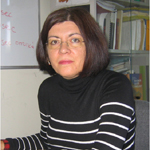

 Prof. Ioanna Zergioti
Prof. Ioanna Zergioti Ioanna Zergioti is an Associate Professor at the National Technical University of Athens, School of Applied Mathematics and Physical Sciences. She studied Physics at the University of Crete and she received PhD at the Foundation for Research and Technology-Hellas. In the framework of her PhD work she worked for the fall semester of 1996 in the Mechanical Engineering Department at the University of California, Berkeley on the Laser Materials Processing. After her PhD, she worked as a post-doctoral researcher in the Max Planck Institut für Biophysikalische Chemie in Göttingen. Then, she worked as a post-doctoral researcher in the Philips CFT until 2000. She was a researcher for 4 years (1999-2003) at the Laser Applications Division of the Institute of Electronic Structure and Laser – FORTH. Since September 2003 she was appointed at the NTUA. Her main activities are related to the laser processing and spectroscopy for electronics and biomedical applications. She has co-authored more than 80 publications in international refereed journals, 90 publications in conference proceedings, 4 chapter in scientific books, 3 granted Greek patents, 1 European patent. She has co-organised large conferences such as CLEO, EMRS, COLA conferences. She is currently coordinating two European Research projects, a Marie Curie IAPP “LaserMicroFab” and an ICT “BIOFOS”.
The ability to directly immobilize biomolecules at specific sites on the sensors’ surfaces is important for the biochip applications. Laser Induced Forward Transfer (LIFT) is a direct printing technique, able to print micropatterns of biomaterials on sensing devices. In this work, we present a new approach of combining the direct laser printing technique (LIFT) with thiol–ene (or –yne) photo-immobilization processes for the immobilization of aptamers. Light-mediated thiol–ene (or –yne) reactions effectively combine the classical benefits of click reactions with the advantages of a photo-initiated process, which can be specifically activated. In combination with the unique properties of the direct laser printing technique, of making micro-patterns with high spatial resolution, this approach results in a powerful method for site-specific covalent immobilization of biomaterials onto sensor surfaces.
Thiol-modified aptamers against Ochratoxin A (OTA) were immobilized on alkene- (or alkyne-) terminated Si3N4 surfaces in a two-step process, i.e. laser printing and activation. Aptamers are oligonucleic acid or peptide molecules that bind to a specific target molecule by modifying their 3D shape. In order to confirm the immobilization efficiency and their functionality against OTA, with fluorescence microscopy, the aptameric sequences were fluorescently tagged.
The printing experiments were carried out, using a pulsed Nd:YAG laser (355 nm, 10 ns) and a high power imaging micromachining system. The laser beam is focused onto a quartz-donor substrate, which is coated with 10 μM aptamers solution. For the site-specific photo-activation of the printed aptamers, a secondary laser beam at 355 nm was used. The shape and the size of the beam was controlled by a square mask.